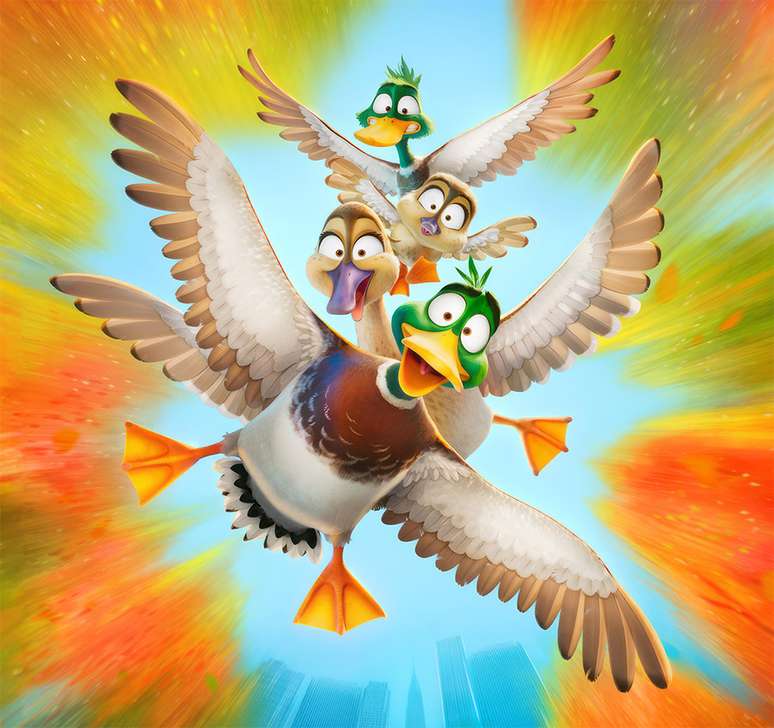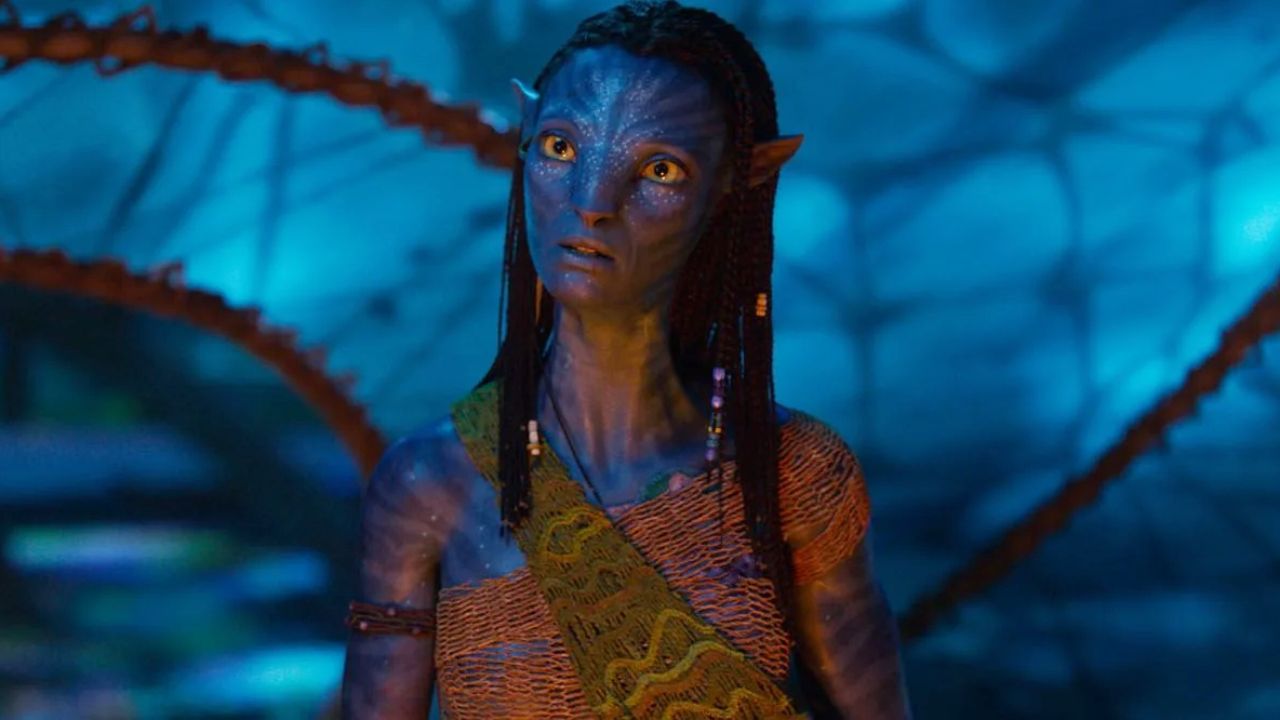Two animations are the main film premieres this Thursday (4/1). Disney waited 40 days to launch “Wish” in Brazil and, despite this, chose a date in which its original animation will have to compete with a strong competitor in terms of audience. “Ducks” is a recent film by Illumination/Universal and in 13 days it was much more successful in the USA, both at the box office and with specialized critics. The biopic on Priscilla Presley, awarded at the Venice Film Festival, and two other titles will also be released in theaters. Check out the latest scheduling details below.
DUCKS!
As the national title indicates, the new animation from Illumination (creator of Minions) follows a family of ducks, the Mallards, who live on a lake in New England, USA. The family’s cautious father, Mack Mallard, prefers to stay on the safe shores of his lake, but his adventurous wife Pam and their children, Dax and Gwen, long to explore the world. Eventually, the family decides to embark on a winter migration to Jamaica, beginning a series of adventures and discoveries.
Although it follows a conventional formula, the film stands out for its innovative visual style. Unlike many contemporary animated productions, “Ducks!” It features a textured aesthetic that conveys a less artificial feel. The landscapes seen from above and the softer color palette create a unique atmosphere, with softer shadows and an almost watercolor effect. This approach reflects the preferences of French director Benjamin Renner, known for delightfully personal animated films like “Ernest & Celestine” (2012) and “The Bad Fox” (2017). The narrative is also enriched by the screenplay by Mike White (creator of “The White Lotus”), which makes the Mallards’ journey punctuated by moments of sophisticated humor enough to entertain adults, while keeping the story accessible and entertaining for younger audiences . .
The original voice cast includes Kumail Nanjiani (“Eternals”) and Elizabeth Banks (“Charlie’s Angels”) as the parents, and Caspar Jennings (“The Sun That Never Was”) and newcomer Tresi Gazal as clothes of their children. Additionally, Awkwafina (“Shang-Chi and the Legend of the Ten Rings”) lends her gruff voice to a tough New York dove, while Danny DeVito (“Haunted Mansion”) and Keegan-Michael (“Shmigadoon!”) play Uncle Dan and a Jamaican parrot. Despite sticking to a familiar formula, the film offers genuine laugh-out-loud moments, presented with a distinctive flair that sets it apart from the current crop of animations.
WISH – THE POWER OF WISHES
Made to celebrate Disney’s centennial, the animation explores the Wishing Star from its classic cartoons and is consciously structured like the studio’s traditional fairy tales, but with a modern approach. Once Upon a Time is set in the utopian kingdom of Rosas, ruled by the sorcerer monarch Magnifico (voiced by Chris Pine, from “Wonder Woman”). In this world, Magnifico confiscates the dearest wishes of his people, guarding them and occasionally granting one. The plot develops as teenager Asha (voiced by Ariana DeBose, from “Amor, Sublime Amor”) realizes that depriving people of their dreams is not the basis for a happy society. She desires a fundamental change in the kingdom, which causes a star to fall from the sky and triggers the central events of the film.
The original voice cast also highlights Alan Tudyk (“Resident Alien”) as the voice of Asha’s goat, named Valentino, whose gift of speech is granted by the child star.
The narrative struggles to find its place, failing to effectively evoke the past to serve as homage, nor being irreverent or innovative enough to justify its constant references. Reflecting this crossroads, its appearance represents an attempt to pay homage to Disney’s hand-drawn animation and digital present by combining three-dimensional and two-dimensional animation. However, the execution does not achieve the desired harmony, resulting in an aesthetic that appears unconvincing and disjointed. To top it off, the film is a musical like old-fashioned cartoons, but its soundtrack has little charm or originality, feeling more like a made-to-order product from a conglomerate than an artistic inspiration. The result was a critical (48% on Rotten Tomatoes) and box office failure in North America, where the $200 million-budgeted production grossed just $61 million in 40 days, less than “Ducks” in 13 days.
PRISCILLA
The biography directed by Sofia Coppola explores the complexity of the life of Priscilla Beaulieu Presley, played by Cailee Spaeny (“Young Witches: New Sisterhood”). The narrative begins when Priscilla, just 14, meets rock icon Elvis Presley, played by Jacob Elordi (“Saltburn”), at a party near an American military base in West Germany. The story follows the evolution of their relationship, from Priscilla’s initial enchantment to the challenges of a life shared with a superstar. The film, adapted from Priscilla Presley’s memoir “Elvis and Me,” presents a dual vision: Priscilla’s personal experience and a modern perspective that questions the nature of her relationship with Elvis.
Coppola captures the loneliness and isolation of Priscilla, a woman caught up in the splendor and expectations of her time. Raised in a world of rigid gender roles, Elvis expects Priscilla to fill the traditional role of wife. The narrative highlights the protagonist’s struggle to adapt to this feminine ideal, highlighted in her costume choices, with sophisticated clothing and, as the story evolves, also in the expression of her independence through prints that Elvis disapproved of. The film explores the complexity of this relationship, avoiding simplistic labels and highlighting the power structures around the singer, which influence all of his relationships.
“Priscilla” is an artistic depiction of Priscilla’s journey through a difficult marriage. The story unfolds gradually, with Elvis’ toxic impact slowly eroding the marriage, as he celebrates female self-discovery and the challenges of forming one’s identity. Her performance in the title role earned Cailee Spaeny the trophy for best actress at the latest Venice Film Festival.
DOGMAN
Director Luc Besson’s return to cinema after turbulent years, in which he faced and escaped a sexual assault lawsuit, revolves around Doug (Caleb Landry Jones), an outcast character in a wheelchair who prefers the company of dogs to that of humans. The film explores Doug’s journey from his traumatic childhood, where he was abused and confined to a cage with dogs by his own father, to his adult life, when he uses his dominance over dogs to carry out criminal activities and, at the same time, he expresses himself artistically through drag queen performances. The narrative is presented through flashbacks, as Doug tells his story to a prison psychologist.
The film has been criticized for its approach to violence, which some consider excessive or unnecessarily graphic. This violence is not just limited to physical action scenes, but also includes psychological and emotional violence, portraying a protagonist who has faced trauma and adversity since childhood. The sequences are presented in a raw and impactful way, reflecting the brutal reality of the world in which Doug lives and the harsh experiences that shape his character and his choices.
On the other hand, it is praised for its distinctive visual appearance. Besson’s photography, known for its unique style and ability to create memorable visual scenes, is a strength of the production. The use of colors, lighting and composition of the scene contributes to creating a dark and aesthetically appealing atmosphere. These visual elements not only complement the narrative, but also deepen the viewer’s immersion in the on-screen universe.
In short, “Dogman” is a film that provokes strong reactions.
THE BEST IS YET TO COME
The Italian director Nanni Moretti, winner of the Palme d’Or for “The Son’s Room” (2001), offers the public a film within a film. Moretti not only directs but also stars in the film as Giovanni, a stubborn director, who plays a narcissistic and self-deprecating figure. At the center of the plot is a film project set in 1956, directed by Giovanni, which portrays a critical moment in political history: the invasion of Hungary by the Soviet Union and the mixed response within the Italian Communist Party . This historical plot is intertwined with nuances of the director’s personal and professional life, including his troubled relationship with his wife and co-producer Paola, played by Margherita Buy, and his reflections on the current state of cinema and the influence of streaming platforms . like Netflix.
Moretti, recognized for his authorial and introspective approach, uses the work as a means to explore and comment – superficially – on the world of cinema, emulating the metafilmic structure of classic works such as Federico Fellini’s “8½”. Just as Fellini used the 1963 masterpiece to explore the creative crises and life of a director, Moretti does something similar, mixing his biography with fiction. He creates work that reflects on his own career, views and personal experiences, placing himself at the center of the narrative as a filmmaker grappling with the commercial demands and artistic challenges of the contemporary film industry.
Despite containing comedic elements and surreal moments, the film doesn’t escape the self-indulgence typical of a vanity project. The appeal of the work depends largely on the viewer’s familiarity with Moretti’s filmography and his appreciation for the director himself.
Source: Terra
Rose James is a Gossipify movie and series reviewer known for her in-depth analysis and unique perspective on the latest releases. With a background in film studies, she provides engaging and informative reviews, and keeps readers up to date with industry trends and emerging talents.






